-
Since Bekenstein and Hawking [1, 2] demonstrated that black holes can be observed as thermodynamic objects with temperature, it is widely accepted that black hole thermodynamics has been an exciting and challenging field in theoretical physics. As fascinating phenomena in black hole thermodynamics, phase transitions and critical behaviors have attracted the attention of several researchers. Based on the analogy between black holes and thermodynamic objects, Hawking and Page proved the existence of a phase transition between the Schwarzschild-AdS black hole and thermal AdS space [3]. After their pioneering research, several studies were conducted in this direction, and rich phase structures were discovered [4−8]. The later-established AdS/CFT correspondence has further stimulated attention toward asymptotically anti-de Sitter (AdS) black holes [9, 10]. In different AdS black hole backgrounds, phase structures and critical phenomena have been studied and promoted [11−19].
Note that the energy definition of Kerr-AdS black holes is not unique. This is because the standard Komar energy expression diverges at infinity. Henneaux and Teitelboim [20] first derived the energy
$ m/\Xi^{2} $ , which satisfies the first law of black hole thermodynamics. The authors [21] proposed the energy$ m/\Xi^{3/2} $ by applying the Hamiltonian approach. Using the Iyer-Wald formalism, Gao et al. [22] clarified the origins of the two different energy definitions of Kerr-AdS black holes. They found the energies associated with different observers at infinity, and there is a relative rotation between the two types of observers. The associated thermodynamics for the different energies are also obtained in [22]. For non-rotating and rotating observers, the energies are$ m/\Xi^{2} $ and$ m/\Xi^{3/2} $ , respectively. The energy$ m/\Xi^{2} $ corresponds to the standard thermodynamics of black hole, and its related critical phenomena have been studied, including phase transition and critical exponents [16]. The other energy$ m/\Xi^{3/2} $ is related to the modified first law of black hole thermodynamics [22]. Considering that the phase transition is associated with the degrees of freedom within the system, and there is only a relative rotation between two observers, it is reasonably conjectured that there should be similar phase structures in modified thermodynamics. In the current study, we investigate whether the phase transition structure exists under the modified first law of thermodynamics. Furthermore, the observer dependence of the phase structure is discussed.This paper is organized as follows. Section II briefly reviews the basic knowledge of the Kerr-AdS black hole. Section III discusses the modified first law and thermodynamic quantities. The main results are presented in Sections IV and V; the phase structure of the modified first law is shown. Discussions are given in the last section.
-
The Kerr-AdS black hole solution of the Einstein equations in the Boyer-Lindquist coordinates is expressed as
$ \begin{aligned}[b] \mathrm{d}s^{2} =\;& - \frac{\Delta}{\rho^2}\big( \mathrm{d}t-\frac{a\sin^2\theta}{\Xi}\mathrm{d}\phi \big)^2+\frac{\rho^2}{\Delta}\mathrm{d}r^{2}\\ &+ \frac{\rho^2}{\Sigma}\mathrm{d}\theta^{2}+\frac{\Xi\sin^2\theta}{\rho^2}\big( a\mathrm{d}t-\frac{r^2+a^2}{\Xi}\mathrm{d}\phi \big)^2, \end{aligned} $

(1) with
$ \begin{aligned}[b] & \rho^2 = r^2+a^2\cos^2\theta,\\ & \Xi = 1-\frac{a^2}{l^2},\\ & \Sigma = 1-\frac{a^2}{l^2}\cos^2\theta,\\ & \Delta = (r^2+a^2)\left(1+\frac{r^2}{l^2}\right)-2mr. \end{aligned} $

(2) Here,
$ \Lambda = -3l^{-2} $ is the cosmological constant,$ m, a $ are the mass parameter and angular momentum parameter, respectively. The associated thermodynamic quantities are [16]$ T = \frac{3r_+^4+(a^2+l^2)r_+^2-l^2a^2}{4\pi l^2r_+(r_+^2+a^2)}, \quad S = \frac{\pi(r_+^2+a^2)}{\Xi}, \quad \Omega_{H} = \frac{a\Xi}{r_+^2+a^2}, $

(3) where
$ r_{+} $ represents the horizon radius satisfying$\Delta(r_{+}) = 0$ ; T, S, and$ \Omega_{H} $ are defined as the Hawking temperature, Bekenstein-Hawking entropy, and angular velocity, respectively. The energy M and angular momentum J are$ M = \dfrac{m}{\Xi^2} $ and$ J = \dfrac{am}{\Xi^2} $ , respectively.In 2012, S. Gunasekaran et al. [23] introduced the extended phase space for AdS black hole, where the cosmological constant Λ can be interpreted as a pressure term via the following relation:
$ P = -\frac{\Lambda}{8\pi}. $

(4) The first law of black hole thermodynamics and the Smarr formula are
$ \delta M = T\delta S+\Omega_{H}\delta J+V\delta P, $

(5) $ \frac{M}{2} = TS+\Omega_{H}J-VP, $

(6) where the thermodynamic volume V is
$ \dfrac{4\pi l^2 r_{+}(a^2+r_{+}^2)}{3(-a^2+l^2)} $ . Following Gunasekaran et al.'s perspective, several studies have focused on exploring the thermodynamic properties of AdS black holes on the extended phase space [24−27]. -
There is ambiguity on the energy notion of Kerr-AdS black holes [20, 21], which has been a long standing issue. In the recent article [22], the authors proposed a natural criteria to justify the notion of energy. In particular, they examined whether the associated first law of the black hole thermodynamics exists. Within the Iyer-Wald formalism, two versions of the first law and the Smarr formula were established for different energies. The difference originated from the choice of the Killing vectors. The standard energy notion
$ m/\Xi^{2} $ is associated with the Killing vector$ \dfrac{\partial}{\partial T} = \dfrac{\partial}{\partial t}+\dfrac{1}{3}a\Lambda \dfrac{\partial}{\partial \phi} $ . The relevant thermodynamic quantities, first law, and standard results are presented in Section II. The other energy notion$\hat{M} = m/\Xi^{3/2}$ is related to the Killing vector$ \dfrac{1}{\sqrt{\Xi}}\dfrac{\partial}{\partial t} $ . By employing the notation from [22], the corresponding thermodynamic quantities can be expressed as$ \hat{\Omega}_{H} = \frac{\Omega_{H}}{\sqrt{\Xi}}, \quad \hat{T} = \frac{T}{\sqrt{\Xi}}, \quad \hat{V} = \frac{V}{\sqrt{\Xi}}. $

(7) The modified first law of black hole thermodynamics is presented as
$ \delta\hat{M} = \hat{T}\delta S+ \hat{\Omega}_{H}\delta J+\hat{V}\delta P. $

(8) Based on the concrete expressions of the Killing vectors, there exists a relative rotation between two types of observers. Contrary to a naive observation,
$ \dfrac{\partial}{\partial T} $ coincides with the generator of the conformal boundary, corresponding to non-rotating observers, whereas rotating observers are related to$ \dfrac{\partial}{\partial t} $ . -
Using Eq. (7), the functions
$ \hat{\Omega}_{H} $ , J, and$ \hat{T} $ can be expressed as$ J = \frac{3a(a^2+r_+^2)(3+8P\pi r_+^2 )}{2(3-8a^2P \pi)^2r_+}, $

(9) $ \hat{\Omega}_{H} = \frac{2a\sqrt{P(-a^2+\dfrac{3}{8P\pi})}\sqrt{\dfrac{2\pi}{3}}}{a^2+r_+^2}, $

(10) $ \hat{T} = \frac{\sqrt{\dfrac{1}{9-24a^2P\pi}}[a^2(-3+8P\pi r_+^2)+3(r_+^2+8P\pi r_+^4)]}{4\pi r_+(a^2+r_+^2) }. $

(11) The above equations can be viewed as equations of state of the Kerr-AdS black hole.
In this section, we focus on the phase structure of modified black hole thermodynamics on the
$ (\hat{\Omega}_{H},J) $ plane. A previous study [16] had considered similar problems for standard black hole thermodynamics on the$ (J,\Omega_{H}) $ section, without considering the extended phase space.According to the equations of state (9)−(11), the isotherms for various temperatures on the
$ \hat{\Omega}_{H}-J $ plane are presented in Fig. 1. Qualitatively, Fig. 1 is similar to the liquid/gas PVT diagram [28]. Under the following correspondence,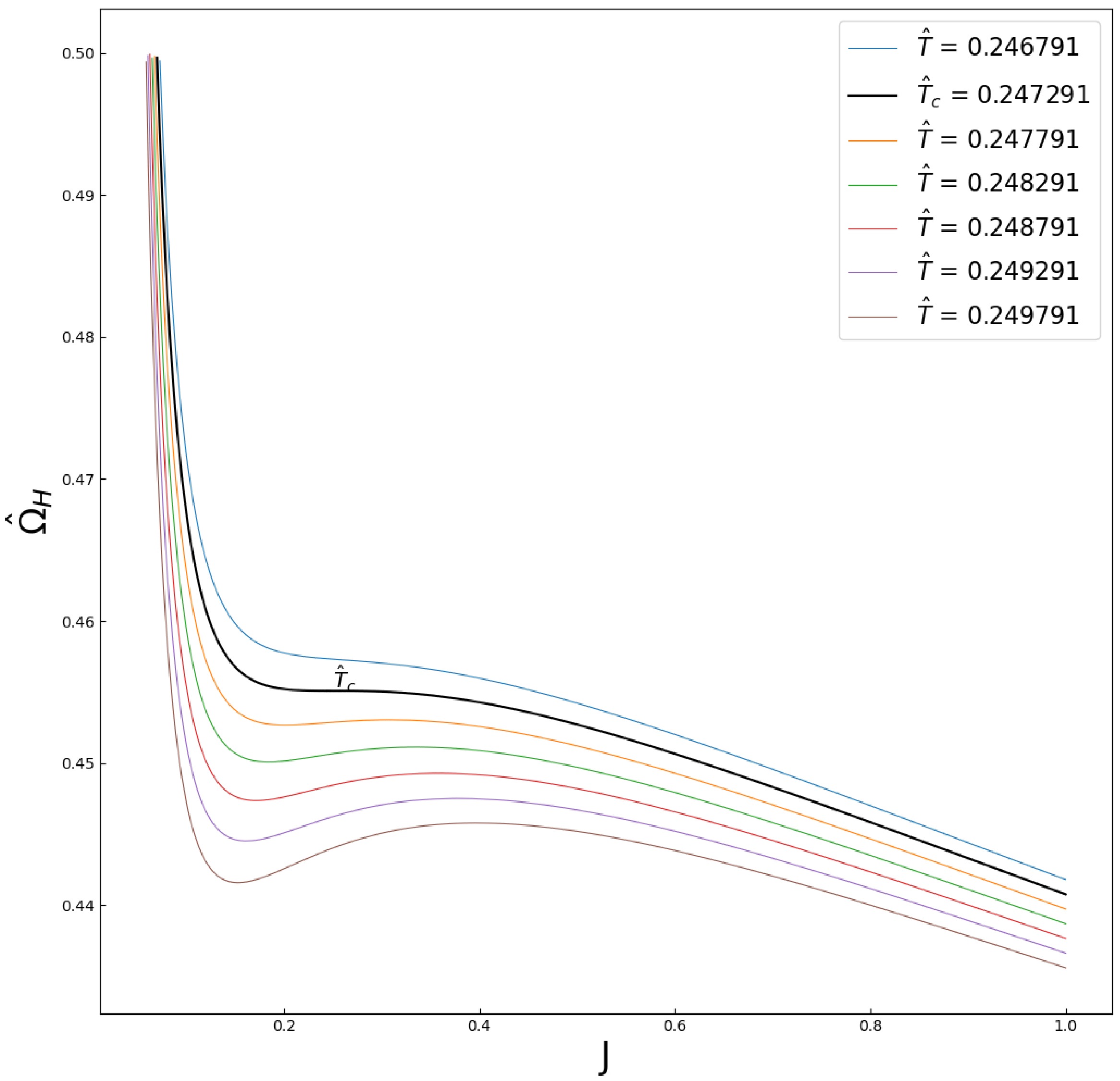
Figure 1. (color online) Isotherms of the Kerr-AdS black hole with
$ l = 1 $ in the$ \hat{\Omega}_{H}-J $ plane. Qualitatively, the isotherms near the critical temperature$ \hat{T}_{c} $ behave similar to a van der Waals system. The black solid line is the critical isotherm.$ \hat{\Omega}_{H}\rightarrow P, J\rightarrow V, $

(12) there is a van der Waals-like phase structure. By contrast, the correspondence in the previous article [16] was
$J\rightarrow P,\; \Omega_{H}\rightarrow V$ .As the temperature decreases until
$ \hat{T}_{c} $ , an inflection point is formed. Therefore, the temperature$ \hat{T}_{c} $ and angular velocity$ \hat{\Omega}_{H} $ at the critical point satisfy [28]$ \left(\frac{\partial \hat{\Omega}_{H} }{\partial J}\right)_{\hat{T}_{c}} = 0, \quad\left(\frac{\partial^2 \hat{\Omega}_{H} }{\partial J^2}\right)_{\hat{T}_{c}} = 0. $

(13) Combining with the equations of state (9)−(11), the critical point is
$ J_{c} = \frac{3(4+\sqrt{2})(1+2\sqrt{2})^{3/2}\sqrt{-5+4\sqrt{2}}(-6+5\sqrt{2})}{448(-3+\sqrt{2})^2P\pi}, $

(14) $ \hat{\Omega}_{Hc} = \frac{2\sqrt{\dfrac{2}{3}(-23+17\sqrt{2})\pi P}}{(-2+3\sqrt{2})}, $

(15) $ \hat T_{c} = \frac{7(-2+3\sqrt{2})\sqrt{\dfrac{2P}{9\pi -3\sqrt{2}\pi}}}{(1+2\sqrt{2})^{3/2}(-6+5\sqrt{2})}. $

(16) -
In this subsection, we first discuss the coexistence condition between two states, from which the law of equal area is obtained. For two stable states,
$ \hat{a} $ and$ \hat{b} $ , it is well-known that the coexistence condition is represented by the free energy being equal [28], i.e.,$ G(\hat{a}) = G(\hat{b}) $ . Compared with the PTV system, the free energy for the black hole system should be$ {\rm{d}}G = -S{\rm{d}}\hat{T}+J{\rm{d}}\hat{\Omega}_{H}. $

(17) Fixing the temperature, one can obtain the free energy by integrating the above equation along the isothermal curve. The difference in free energy between two states should be
$ \int_{\hat{a}}^{\hat{b}}J {\rm{d}}\hat{\Omega}_{H} $ (this integral is along the isothermal curve that connects the two states). From Fig. 2(a), because$ \hat{a} $ and$ \hat{b} $ are coexistent states,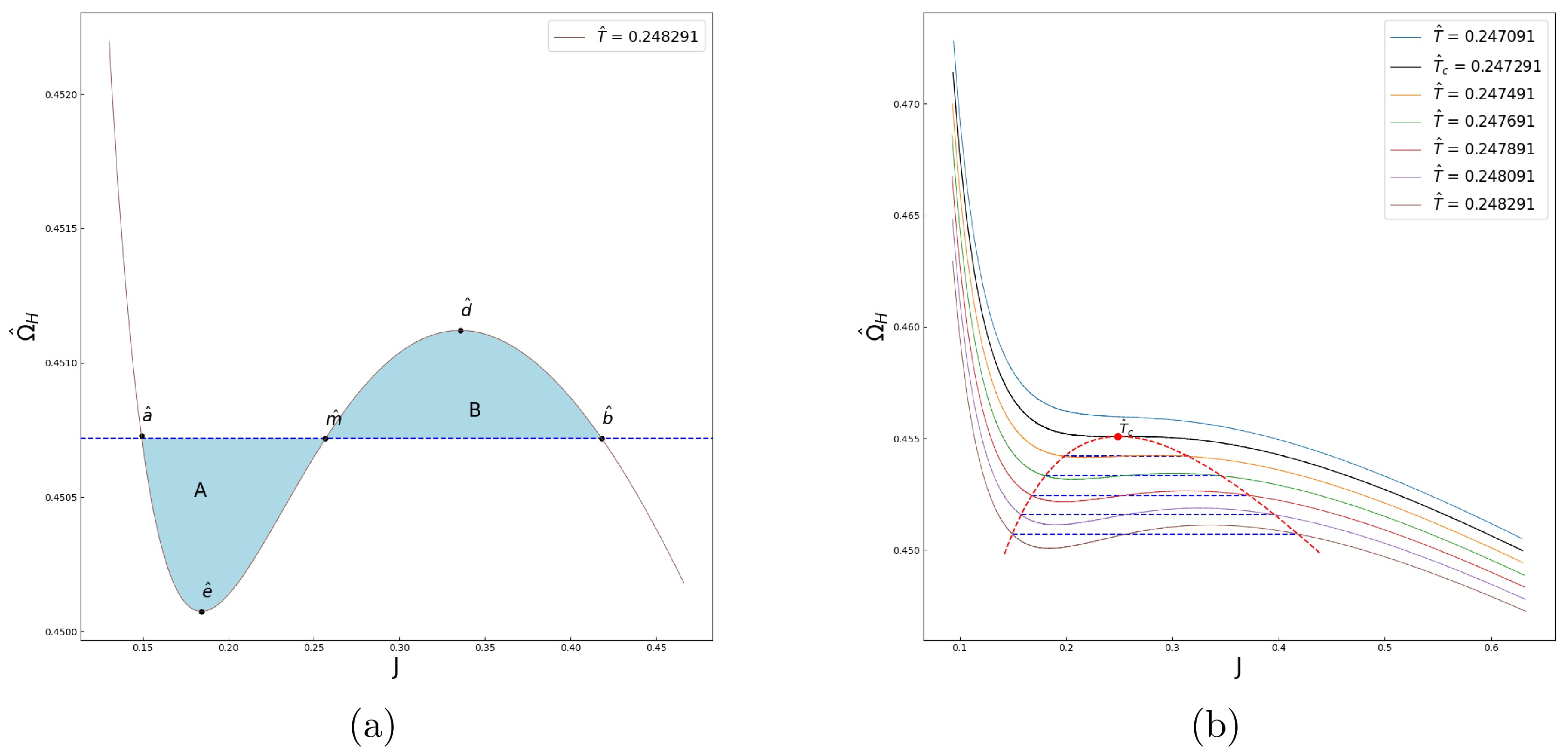
Figure 2. (color online) (a) The brown solid line represents an isotherm with temperature
$ \hat{T} = 0.248291 $ and$ l = 1 $ ;$ \hat{a} $ and$ \hat{b} $ are coexistence states. Because of the equal free energy requirement of coexistence states, i.e.,$ G(\hat{a}) = G(\hat{b}) $ , area(A) = area(B). (b) The red dashed line is the coexistence curve of phase transition above$ \hat{T}_{c} $ . The black solid line represents the critical isotherm with$ l = 1 $ .$ G(\hat{a})-G(\hat{b}) = \int_{\hat{\Omega}_{H\hat{a}}}^{\hat{\Omega}_{H\hat{b}}}J {\rm{d}}\hat{\Omega}_{H} = 0, $

(18) implying that the areas of region A and region B in Fig. 2(a) are equal, corresponding to the Maxwell equal area law.
To investigate the critical behavior near the critical point, we should define the order parameter. Analogous to the van der Waals system,
$ \eta = \dfrac{J_{b}-J_{a}}{2} $ is defined as the order parameter. The coexistence curve is the red dashed line in Fig. 2(b). -
For a van der Waals system, near the critical point, one can obtain the critical exponents [28]. For the correspondence (12), the analogous critical exponents can be obtained as follows.
$ \bullet $ Degree of critical isotherm:$ \hat{\Omega}_{H}-\hat{\Omega}_{Hc} = A_{\delta}\lvert J-J_{c}\rvert^\delta {\rm sign} (J-J_{c}),\qquad \hat{T} = \hat{T}_{c}. $

(19) $ \bullet $ Degree of coexistence curve:$ \eta = -A_{\beta}(\hat{T}-\hat{T}_{c})^\beta,\qquad \hat{T}>\hat{T}_{c}. $

(20) $ \bullet $ Degree of heat capacity($ J = J_{c} $ ):$ C_{J} = \left\{ \begin{array}{l} A_{\alpha'}\left\{-(\hat{T}-\hat{T}_{c})\right\}^{-\alpha'},\quad \hat{T}<\hat{T}_{c}\\ A_{\alpha}\left\{+(\hat{T}-\hat{T}_{c})\right\}^{-\alpha}, \quad \hat{T}>\hat{T}_{c}. \end{array} \right . $

(21) $ \bullet $ Degree of isothermal compressibility:$ \kappa{_{T}} = -\frac{1}{J}\left(\frac{\partial J }{\partial \hat{\Omega}_{H}}\right)_{\hat T} = \left\{ \begin{array}{l} A_{\gamma'}\left\{-(\hat{T}-\hat{T}_{c})\right\}^{-\gamma'},\quad \hat{T}<\hat{T}_{c}\\ A_{\gamma}\left\{+(\hat{T}-\hat{T}_{c})\right\}^{-\gamma}, \quad \hat{T}>\hat{T}_{c}. \end{array} \right . $

(22) In the following subseciton, we calculate explicitly the critical exponents for modified black hole thermodynamics.
-
At the critical point, the first and second derivatives of
$ \hat{\Omega}_{H} $ with respect to J satisfy$ \big(\frac{\partial \hat{\Omega}_{H} }{\partial J}\big)_{\hat T_{c}} = 0, \quad\big(\frac{\partial^2 \hat{\Omega}_{H} }{\partial J^2}\big)_{\hat T_{c}} = 0. $

(23) The third derivative can be calculated as
$ \big(\frac{\partial^3 \hat{\Omega}_{H} }{\partial J^3}\big)_{\hat T_{c}} = -\frac{16384 (\pi P) ^{7/2}}{9 \sqrt{87 \sqrt{2}+123} }\neq 0, $

(24) hence,
$ \delta = 3 $ according to the definition of δ in Eq. (19). -
In Fig. 2(b), we plot the curve of the coexisting states using Maxwell's equal-area law. Along this curve, all thermodynamical quantities depend only on temperature. To find the value of the degree of the coexistence curve, β, we should obtain the relations between η and
$ \hat T $ near the critical point. Therefore, we expand$ \hat{\Omega}_{H} $ in terms of J and$ \hat{T} $ to the third order as$ \begin{aligned}[b] \hat{\Omega}_{H}-\hat{\Omega}_{Hc}\approx \;& (\partial_{\hat{T}}\hat{\Omega}_{H})_{J}\vert_{c}(\hat{T}-\hat{T}_{c})+\frac{1}{2}(\partial^2_{\hat{T}}\hat{\Omega}_{H})_{J}\vert_{c}(\hat{T}-\hat{T}_{c})^2\\&+ \big(\partial_ {\hat{T}}(\partial _{J}\hat{\Omega}_{H})_{\hat{T}}\big)_{J}\vert_{c}(\hat{T}-\hat{T}_{c})(J-J_{c})\\ &+\frac{1}{6}(\partial^3_{\hat{T}}\hat{\Omega}_{H})_{J}\vert_{c}(\hat{T}-\hat{T}_{c})^3+ \frac{1}{6}(\partial^3_{J}\hat{\Omega}_{H})_{\hat{T}}\vert_{c}(J-J_{c})^3\\ &+\frac{1}{2}\big(\partial^2_ {\hat{T}}(\partial _{J}\hat{\Omega}_{H})_{\hat{T}}\big)_{J}\vert_{c}(\hat{T}-\hat{T}_{c})^2(J-J_{c})\\ &+ \frac{1}{2}\big(\partial_ {\hat{T}}(\partial^2 _{J}\hat{\Omega}_{H})_{\hat{T}}\big)_{J}\vert_{c}(\hat{T}-\hat{T}_{c})(J-J_{c})^2. \end{aligned}$

(25) For simplicity, let us introduce
$ \omega = \hat{\Omega}_{H}-\hat{\Omega}_{Hc},\qquad \overline{t} = \hat{T}-\hat{T}_{c},\qquad j = J-J_{c}, $

(26) then, Eq. (25) becomes
$ \omega = c_{10}\overline{t}+c_{20}\overline{t}^2+c_{11}\overline{t}j+c_{30}\overline{t}^3+c_{03}j^3+c_{21}\overline{t}^2j+c_{12}\overline{t}j^2. $

(27) According to the equations of state (9)−(11), one can calculate all coefficients in Eq. (27) as
$ \begin{aligned}[b]& c_{10} = -\sqrt{2} \pi, \quad c_{20} = \sqrt{6 \left(29 \sqrt{2}-41\right)} \pi ^{3/2} \sqrt{\frac{1}{P}}, \\& c_{11} = \frac{64}{3} \left(\sqrt{2}-1\right) \pi ^2 P,\quad \ c_{30} = \frac{9 \left(11 \sqrt{2}-15\right) \pi ^2}{P}, \\& c_{03} = -\frac{16384 (\pi P) ^{7/2}}{9 \sqrt{87 \sqrt{2}+123} },\\& c_{21} = -{544 \sqrt{\frac{2P}{5331 \sqrt{2}+7539}} \pi ^{5/2}}, \\& c_{12} = \frac{2048}{3} \left(4-3 \sqrt{2}\right) \pi ^3 P^2. \end{aligned} $

(28) The equilibrium condition
$ \hat{\Omega}_a = \hat{\Omega}_b $ implies$ \omega(j_{a},t) = \omega(j_{b},t) $ , which in turn yields$ \begin{aligned}[b] \omega_b-\omega_a =\;& (j_{b}-j_{a})\big[c_{11}\overline{t}+c_{21}\overline{t}^2+c_{12}\overline{t}(j_{a}+j_{b})\\&+c_{03}(j_{a}^2+j_{a}j_{b}+j_{b}^2)\big] = 0. \end{aligned} $

(29) By employing Maxwell's equal area law, the area of the shaded region in Fig. 3 is equal to the area of the rectangle
$ cd\hat{b}\hat{a} $ in Fig. 3. Therefore, we obtain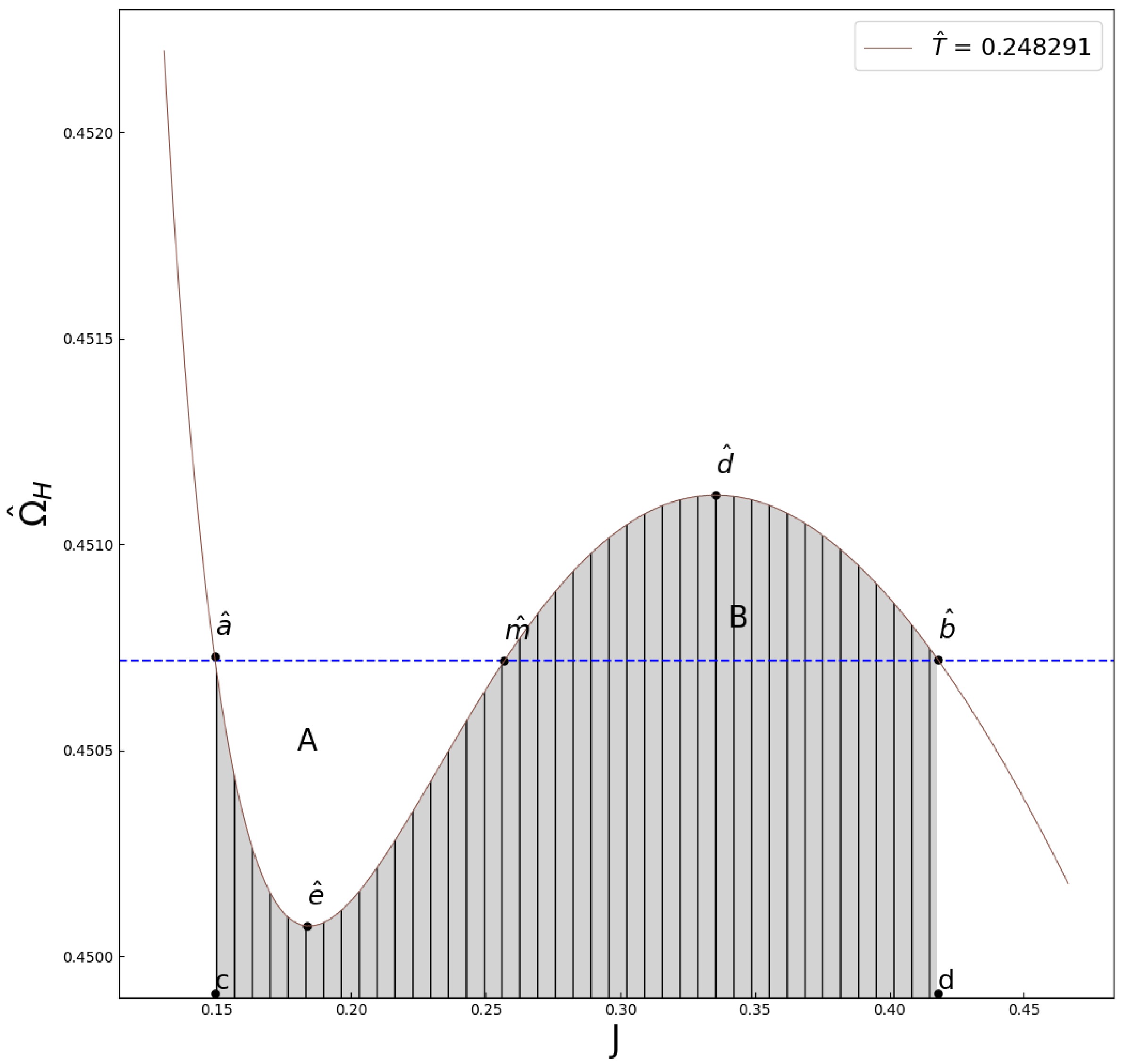
Figure 3. (color online) According to the equal area law, i.e., area(A) = area(B), the area of the shaded region should be equal to the area of the rectangle
$ cd\hat{b}\hat{a} $ .$ \int^{J_b}_{J_a}{\hat\Omega}{\rm d}J = (J_b-J_a)\cdot \frac{1}{2}(\Omega_b+\Omega_a), $

(30) The left side of Eq. (30) represents the area of the shaded region in Fig. 3 , and the right side represents the area of the rectangle cdba in Fig. 3. The factor
$ \dfrac{1}{2}(\Omega_b+\Omega_a) $ originates from the equilibrium condition$ {\hat\Omega}_a = {\hat\Omega}_b $ .) By using Eq. (26), Eq. (30) becomes$ \begin{aligned}[b] \int^{J_b}_{J_a}{\hat\Omega}{\rm d}J =\;& \left[\int^{J_b}_{J_a}({\hat\Omega}-{\hat\Omega}_c){\rm d}(J-J_c)\right]+{\hat\Omega}_c[(J_b-J_c)-(J_a-J_c)]\\ =\;& \left[\int^{j_b}_{j_a}({\hat\Omega}-{\hat\Omega}_c){\rm d}j\right]+{\hat\Omega}_c(j_b-j_a)\\ =\;& \left[\int^{j_b}_{j_a}\omega {\rm d}j\right]+{\hat\Omega}_c(j_b-j_a)\\ =\;& (J_b-J_a)\frac{1}{2}({\hat\Omega}_b+{\hat\Omega}_a)\\ =\;& (j_b-j_a)\frac{1}{2}([{\hat\Omega}_b-{\hat\Omega}_c]+[{\hat\Omega}_a-{\hat\Omega}_c])+(j_b-j_a){\hat\Omega}_c\\ =\;& (j_b-j_a)\frac{1}{2}(\omega_b+\omega_a)+(j_b-j_a){\hat\Omega}_c. \end{aligned} $

(31) The above result implies that
$ \int^{j_b}_{j_a}\omega {\rm d}j = (j_b-j_a)\frac{1}{2}(\omega_b+\omega_a). $

(32) Substituting Eq. (27) into Eq. (32), one can obtain
$ \begin{aligned}[b]\qquad & \int_{j_{a}}^{j_{b}}(c_{10}\overline{t}+c_{20}\overline{t}^2+c_{11}\overline{t}j+c_{30}\overline{t}^3+c_{03}j^3+c_{21}\overline{t}^2j+c_{12}\overline{t}j^2) {\rm{d}}j\\ =\;& c_{10}\overline{t}(j_{b}-j_{a})+c_{20}\overline{t}^2(j_{b}-j_{a})+\frac{1}{2}c_{11}\overline{t}(j_{b}^2-j_{a}^2)+c_{30}\overline{t}^3(j_{b}-j_{a})\\&+\frac{1}{4}c_{03}(j_{b}+j_{a})(j_{b}^2+j_{a}^2)\\&+\frac{1}{2}c_{21}\overline{t}^2(j_{b}+j_{a})+\frac{1}{3}c_{12}\overline{t}(j_{b}^2+j_{a}j_{b}+j_{a}^2)]\\ =\;& (j_{b}-j_{a})\frac{1}{2}(\omega_{a}+\omega_{b}), \end{aligned} $

(33) dividing both sides of Eq. (33) by
$ (j_{b}-j_{a}) $ yields$ \begin{aligned}[b]& c_{10}\overline{t}+c_{20}\overline{t}^2+\frac{1}{2}c_{11}\overline{t}(j_{b}+j_{a})+c_{30}\overline{t}^3\\&+\frac{1}{4}c_{03}(j_{b}+j_{a})(j_{b}^2+j_{a}^2)+\frac{1}{2}c_{21}\overline{t}^2(j_{b}+j_{a})\\& +\frac{1}{3}c_{12}\overline{t}(j_{b}^2+j_{a}j_{b}+j_{a}^2)\\ =\;& c_{10}\overline{t}+c_{20}\overline{t}^2+\frac{1}{2}c_{11}\overline{t}(j_{b}+j_{a})+c_{30}\overline{t}^3\\ &+\frac{1}{2}c_{03}(j_{b}^3+j_{a}^3) +\frac{1}{2}c_{21}\overline{t}^2(j_{b}+j_{a})+\frac{1}{2}c_{12}\overline{t}(j_{b}^2+j_{a}^2). \end{aligned} $

(34) Eliminating similar terms on both sides of Eq. (34) yields
$ \begin{aligned}[b]& \frac{1}{4}c_{03}(j_{b}+j_{a})(j_{b}^2+j_{a}^2)+\frac{1}{3}c_{12}\overline{t}(j_{b}^2+j_{a}j_{b}+j_{a}^2)\\ =\;& \frac{1}{2}c_{03}(j_{b}^3+j_{a}^3)+\frac{1}{2}c_{12}\overline{t}(j_{b}^2+j_{a}^2). \end{aligned}$

(35) Then, we can obtain
$ \begin{aligned}[b]& \frac{1}{4}c_{03}(j_{b}^3+j_{b}^2j_{a}+j_{b}j_{a}^2+j_{a}^3)+\frac{1}{3}c_{12}\overline{t}(j_{b}^2+j_{a}j_{b}+j_{a}^2)\\ =\;& \frac{1}{2}c_{03}(j_{b}^3+j_{a}^3)+\frac{1}{2}c_{12}\overline{t}(j_{b}^2+j_{a}^2), \end{aligned} $

(36) which implies
$ \begin{aligned}[b] 0 =\;& \frac{1}{4}c_{03}(j_{a}^3-j_{a}j_{b}^2-j_{a}^2j_{b}+j_{b}^3)+\frac{1}{6}c_{12}\overline{t}(j_{b}^2-2j_{a}j_{b}+j_{a}^2)\\ =\;& \frac{1}{4}c_{03}(j_{b}+j_{a})(j_{b}-j_{a})^2+\frac{1}{6}c_{12}\overline{t}(j_{b}-j_{a})^2. \end{aligned}$

(37) By simplifying the above equation, we can obtain
$ \begin{split} (j_{b}-j_{a})^2\left[\frac{1}{4}c_{03}(j_{a}+j_{b})+\frac{1}{6}c_{12}\overline{t}\right] = 0. \end{split} $

(38) Denoting
$ j_{-}\equiv j_{b}-j_{a} = J_{b}-J_{a}, j_{+}\equiv j_{b}+j_{a} $ and considering Eq. (38),$ j_{+} $ can be solved as$ j_+ = -\frac{2c_{12}\overline{t}}{3c_{03}}, $

(39) Substituting Eq. (39) into Eq. (29) yields
$ j_- = \sqrt{\frac{-4c_{11}\overline{t}+\left(\dfrac{4c_{12}^2}{3c_{03}}-4c_{21}\right)\overline{t}^2}{c_{03}}}. $

(40) Near the critical point, the temperature dependence of the order parameter is
$ \frac{J_{b}-J_{a}}{2}\approx A_{\beta}(\hat{T}-\hat{T}_{c})^{1/2}. $

(41) Thus,
$ \beta = \dfrac{1}{2} $ . -
According to definition (21), the critical exponent of heat capacity can be obtained as follows. Recall that the energy
$ \hat{M} $ is expressed by$ \hat{M} = \frac{\left(a^2+r_+^2\right) \left(\dfrac{r_+^2}{l^2}+1\right)}{2 r_+ \left(1-\dfrac{a^2}{l^2}\right)^{3/2}}, $

(42) then, the heat capacity
$ C_{J} $ can be calculated as$ C_{J} = \big(\frac{\partial\hat{M}}{\partial\hat{T}}\big)_{J}\rvert_{c} = \frac{3}{8P}\neq0. $

(43) Since the heat capacity neither diverges nor vanishes, α and
$ \alpha' $ are both zero, i.e.,$ \alpha = \alpha' = 0 $ . -
The isothermal comprssibility
$ \kappa{_{T}} $ is defined as$ \kappa{_{T}} = -\frac{1}{J}\left(\frac{\partial J }{\partial \hat{\Omega}_{H}}\right)_{\hat T}, $

(44) which diverges at the critical point.
$ \widetilde{\omega},\widetilde{t} $ , and$ \widetilde{j} $ are introduced as$ \widetilde{\omega} = \frac{\hat{\Omega}_{H}-\hat{\Omega}_{Hc}}{\hat{\Omega}_{Hc}},\quad \widetilde{t} = \frac{\hat{T}-\hat{T}_{c}}{\hat{T}_{c}},\quad \widetilde{j} = \frac{J-J_{c}}{J_{c}}, $

(45) which yields
$ \hat{\Omega}_{H} = \hat{\Omega}_{Hc}\widetilde{\omega}+\hat{\Omega}_{Hc},\quad \hat{T} = \hat{T}_{c}\widetilde{t}+\hat{T}_{c},\quad J = J_{c}\widetilde{j}+J_{c}, $

(46) and
$ \omega = \hat{\Omega}_{Hc}\widetilde{\omega},\quad \overline{t} = \hat{T}_{c}\widetilde{t},\quad j = J_{c}\widetilde{j}. $

(47) Eq. (27) can be rewritten as
$ \widetilde{\omega} = \widetilde{c_{10}}\widetilde{t}+\widetilde{c_{20}}\widetilde{t}^2+\widetilde{c_{11}}\widetilde{t}\widetilde{j}+\widetilde{c_{30}}\widetilde{t}^3+\widetilde{c_{03}}\widetilde{j}^3+\widetilde{c_{21}}\widetilde{t}^2\widetilde{j}+\widetilde{c_{12}}\widetilde{t}\widetilde{j}^2. $

(48) Using Eq. (44), we obtain
$ \frac{-1}{J\kappa{_{T}}} = \frac{1}{\left(\dfrac{\partial J }{\partial \hat{\Omega}_{H}}\right)_{\hat T}} = \left(\frac{\partial \hat{\Omega}_{H} }{\partial J}\right)_{\hat T}. $

(49) Combining Eqs. (41), (46), (47), and (48) yields
$ \frac{-1}{J\kappa{_{T}}} = \left(\frac{\partial \hat{\Omega}_{H} }{\partial J}\right)_{\hat T} = \left(\frac{\partial\hat{\Omega}_{H}}{\partial \widetilde{j}}\frac{\partial \widetilde{j}}{\partial J}\right)_{\hat{T}} = \frac{\hat{\Omega}_{Hc}}{J_{c}}\left(\frac{\partial \widetilde{\omega}}{\partial \widetilde{j}}\right)_{\widetilde{t}}\propto\left(\frac{\partial \omega}{\partial j }\right)_{\overline{t}}, $

(50) namely
$ \kappa{_{T}}^{-1}\propto\big(\frac{\partial \omega}{\partial j }\big)_{\overline{t}} = c_{11}\overline{t}+3c_{03}j^2+o(\overline t) = C_{1}\overline{t}+o(\overline t), $

(51) where
$ C_{1} $ is a real constant; Eq. (41) is used in the last step. Based on the definition of γ and$ \gamma' $ in Eq. (22), we obtain$ \gamma = \gamma' = 1 $ . -
According to the differential expression
$ {\rm{d}}G = -S{\rm{d}}\hat{T}+ J{\rm{d}}\hat{\Omega}_{H} $ , at constant angular velocity$ \hat{\Omega}_{H} $ , we can employ Eqs. (3), (10), and (11) to plot the$ G-\hat{T} $ diagram.From Fig. 4, the swallowtail structure is analogous to the van der Waals system. This further confirms the similarity between the modified thermodynamics and the PVT system.
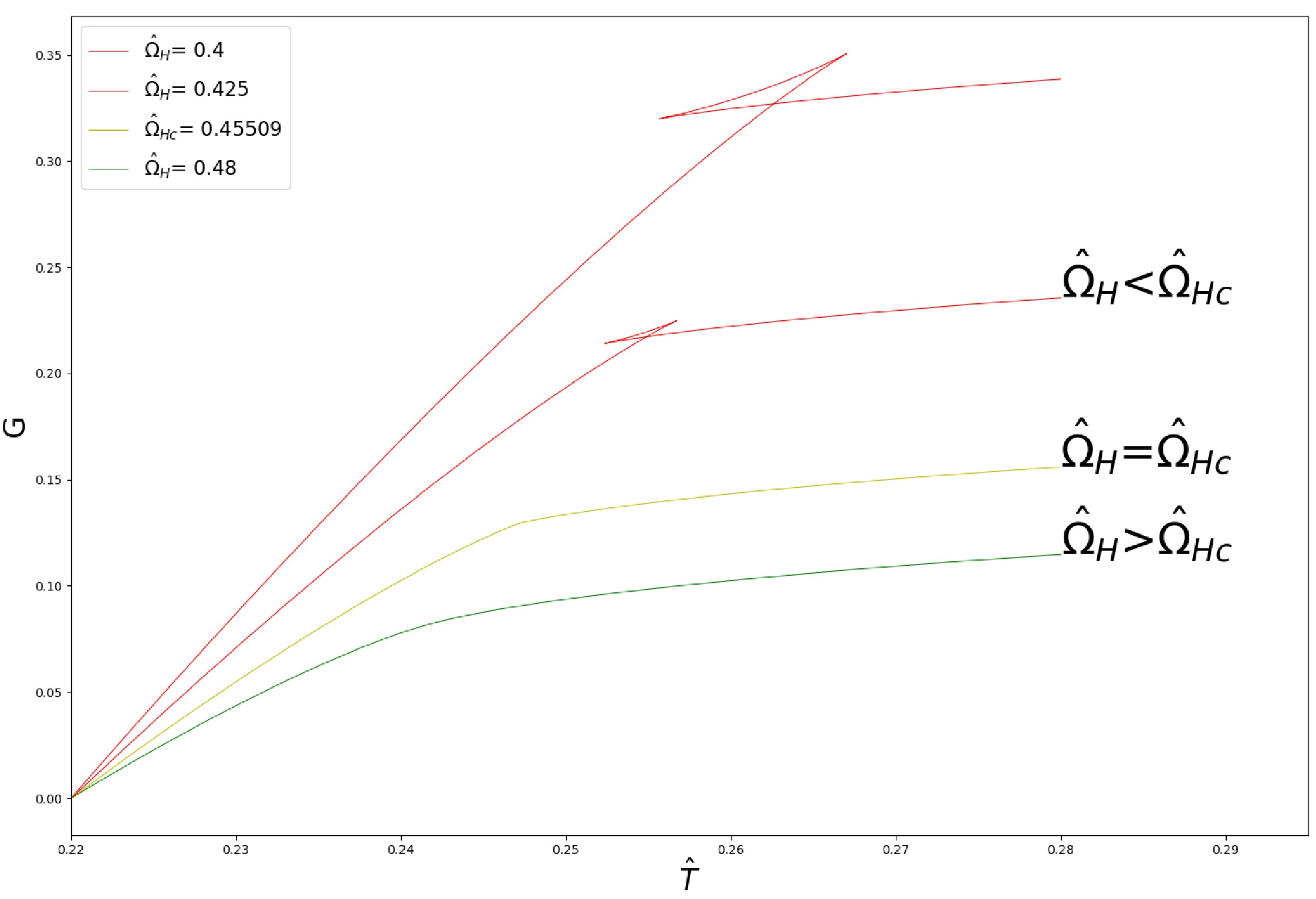
Figure 4. (color online) Qualitative behavior of free energy as a function of temperature for various angular velocities with
$ l = 1 $ . The angular velocity decreases from bottom to top. The green solid line corresponds to$ \hat{\Omega}_{H}>\hat{\Omega}_{Hc} $ , the yellow solid line represents$ \hat{\Omega}_{H} = \hat{\Omega}_{Hc} $ , and the remaining red solid lines correspond to$ \hat{\Omega}_{H}<\hat{\Omega}_{Hc} $ . For$ \hat{\Omega}_{H}<\hat{\Omega}_{Hc} $ , the existence of the swallowtail structure implies that a first-order phase transition occurs in the system. -
It is well-known that, in the vicinity of the critical point, the free energy can be expressed as a homogenous function, with corresponding homogenous indices p and q [28]. Based on the previous discussions, we observe that the critical exponents satisfy the following expected relations:
$ \alpha+2\beta+\gamma = 2, \quad \alpha+\beta(\gamma+1) = 2, $

(52) $ \gamma(\delta+1) = (2-\alpha)(\delta-1), \quad \gamma = \beta(\delta-1). $

(53) The free energy has the following scaling symmetry
$ g_{s}(\Lambda^p \epsilon,\Lambda^q j) = \Lambda g_{s}(\epsilon,j),\quad p = \frac{1}{2},\quad q = \frac{3}{4}. $

(54) In terms of p and q [28], the critical exponets read
$ \alpha = \frac{2p-1}{q}, $

(55) $ \beta = \frac{1-q}{p}, $

(56) $ \gamma = \frac{2q-1}{p}, $

(57) $ \delta = \frac{q}{1-q}. $

(58) The above scaling relations can be considered as consistency checks for the critical exponents we obtained in this section.
-
In standard black hole thermodynamics, the phase structure on the
$ (P,V) $ section has been investigated [17−19, 23, 29]. In this section, we study the phase structures on the (P,$ \hat{V} $ ) section in modified black hole thermodynamics. In Fig. 5, we plot the$ P-\hat{V} $ diagram corresponding to the Kerr-AdS black hole.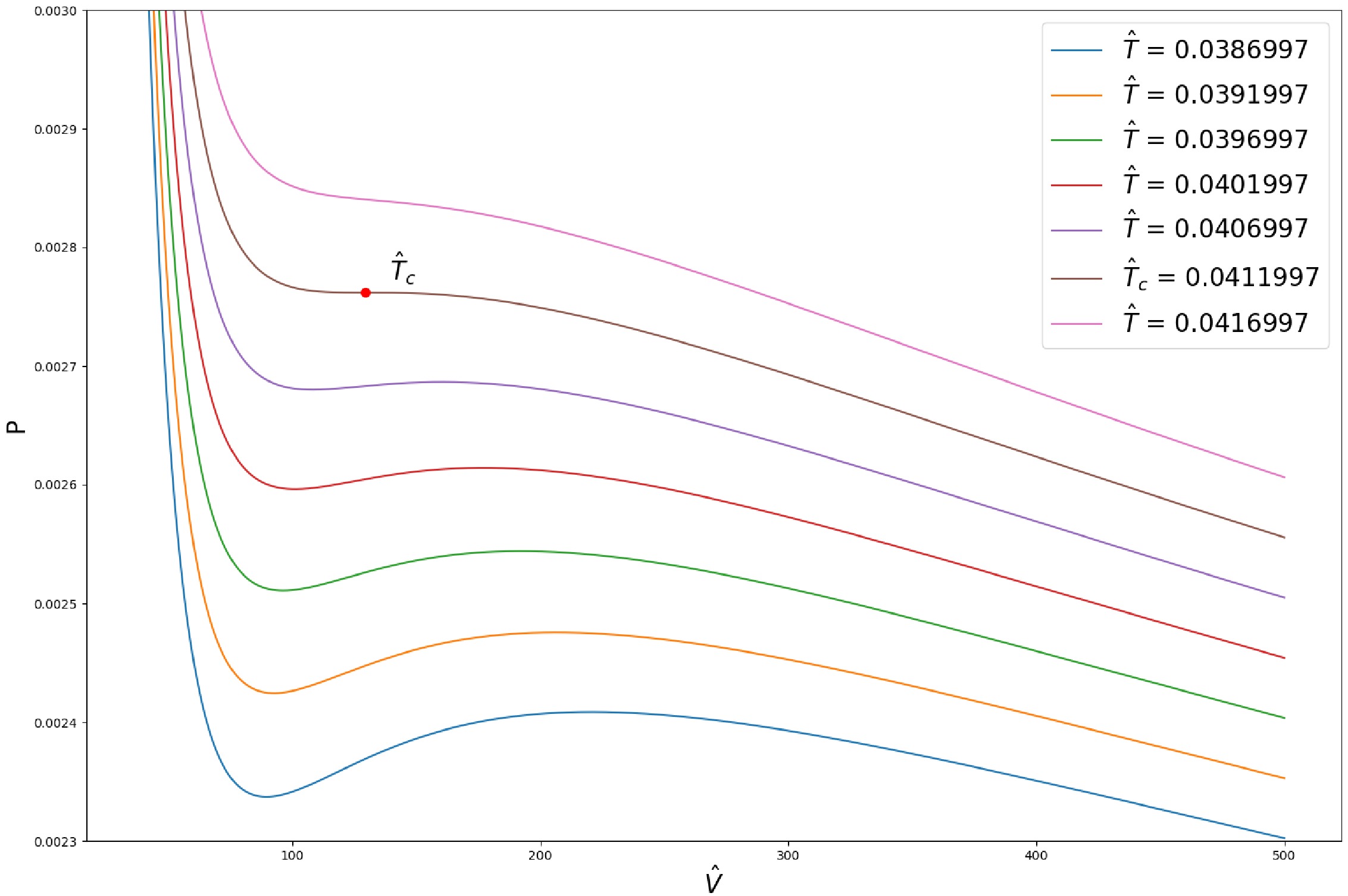
Figure 5. (color online) P-
$ \hat{V} $ diagram of the Kerr-AdS black hole with$ J = 1 $ . The brown solid line is the critical isotherm, and the red dot is the critical point.Following the method used in [29], after neglecting all higher order terms of J, the equation of state can be written as
$ P = \frac{\sqrt[3]{\dfrac{\pi }{6}}\hat{T} }{\sqrt[3]{\hat{V}}}-\frac{1}{2\ 6^{2/3} \sqrt[3]{\pi }\hat{V}^{2/3}}+\frac{2 \pi J^2 \left(4 \sqrt[3]{6} \pi ^{2/3} \hat{T} \sqrt[3]{\hat{V}}+3\right)}{3 \left(\sqrt[3]{6} \pi ^{2/3} \hat{T} \hat{V}^{4/3}+\hat{V} \right)^2}, $

(59) where
$ \hat{V} $ satisfies$ \hat{V} = \frac{4 \pi r_+^3}{3}+\frac{48 \pi \left(4 \pi P r_+^2+1\right)J^2}{r_+ \left(8 \pi P r_+^2+3\right)^2}. $

(60) Following the critical point condition
$ \dfrac{\partial P}{\partial \hat V}\big|_{T_C} = 0, \dfrac{\partial^2 P}{\partial \hat V^2}\big|_{T_C} = 0 $ , we can obtain$ P_{c} = \frac{0.003}{ J},\quad\hat{V}_{c} = 129.603 J^{3/2},\quad\hat{T}_{c} = \frac{0.041}{ \sqrt{J}}. $

(61) Consider the phase transition that occurs below the critical temperature
$ \hat T_{c} $ . In Fig. 5, a van der Waals-like phase structure can be observed. The behavior of physical variables near the critical point is quantitatively described by the critical exponents. Following a similar method as in Section IV, we obtain$ \alpha = \alpha' = 0, \quad \beta = \frac{1}{2},\quad \gamma = 1,\quad \delta = 3. $

(62) The above results show that the phase structure for the modified black hole thermodynamics in the
$ (P,\hat{V}) $ section is almost the same as the standard one [30, 31]; the only difference is that all thermal quantities have a deformation factor$ \dfrac{1}{\sqrt{\Xi}} $ , which is shown in Eq. (7). -
In Kerr-AdS spacetime, there exist two sets of the first law of thermodynamics because of different choices of observers at infinity. In particular, we investigated the critical phenomena of black hole thermodynamics associated with rotating observers. Based on the modified first law and mass formula, we obtained the phase structures in the extended phase space for both the
$ (\hat{\Omega}_{H},J) $ cross-section and$ (P,\hat{V}) $ cross-section. In comparison with previous results [16], the phase structure within the$ (\hat{\Omega}_{H},J) $ plane remained analogous to the van der Waals-like phase structure. However, the difference was in the correspondence of thermodynamic quantities. According to a previous study [16], the correspondence is$ J\rightarrow P $ ,$ \Omega_{H}\rightarrow V $ , but in our case, it is$ \hat{\Omega}_{H}\rightarrow P, J\rightarrow V $ . The aforementioned changes result from differences in observers. Compared to non-rotating observers, the energy measured by rotating observers includes a rotational kinetic energy part$ \sim\hat{\Omega}_{H}J $ . This variation is equivalent to performing a Legendre transformation in the extended phase space with respect to the conjugate coordinates J and$ \hat{\Omega}_{H} $ ; thus, the thermodynamic quantities correspond differently. Additionally, we discussed the phase structures on the$ (P,\hat{V}) $ plane in modified thermodynamics. We found that the obtained results closely resemble those in standard thermodynamics. -
The authors thank Xiaokai He and Naqing Xie for their useful advice. The authors also thank the referees for their valuable comments and suggestions. These opinions have greatly enhanced the quality of this paper.
Phase transition in modified thermodynamics of Kerr-AdS black holes
- Received Date: 2024-09-09
- Available Online: 2025-01-15
Abstract: In this study, we investigate the critical phenomena of Kerr-AdS black holes under the modified first law of thermodynamics. Specifically, we considered modified black hole thermodynamics that exhibit a van der Waals-like phase structure. All critical exponents were calculated, and then, a swallowtail diagram of free energy was plotted. Comparing with existing results, the main difference is the correspondence between the thermal quantities of Kerr-AdS black holes and the van der Waals system. In a previous study [Y. D. Tsai, X. N. Wu, and Y. Yang, Phys. Rev. D 85 044005 (2012)], the correspondence was





 Abstract
Abstract HTML
HTML Reference
Reference Related
Related PDF
PDF




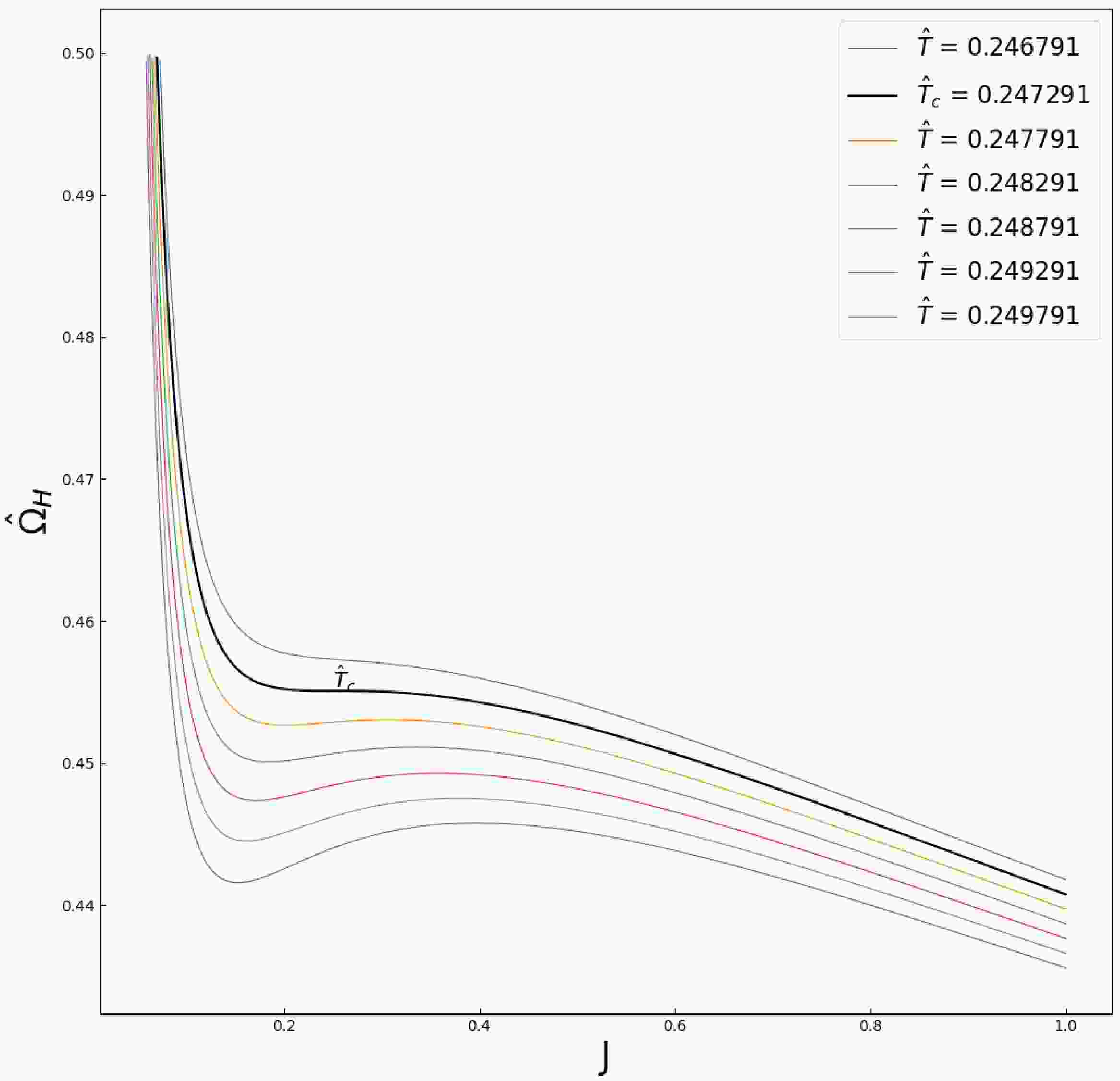













 DownLoad:
DownLoad: